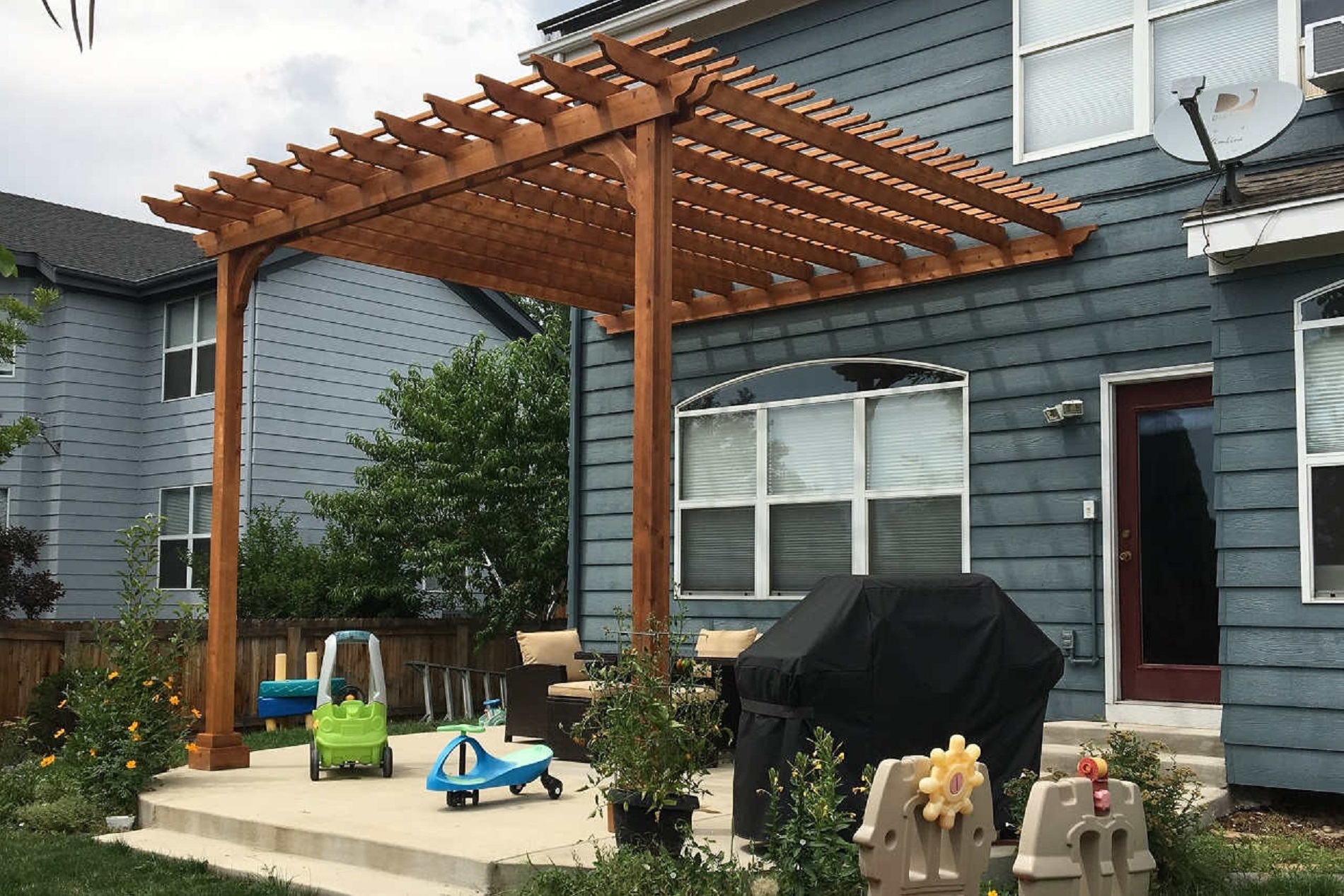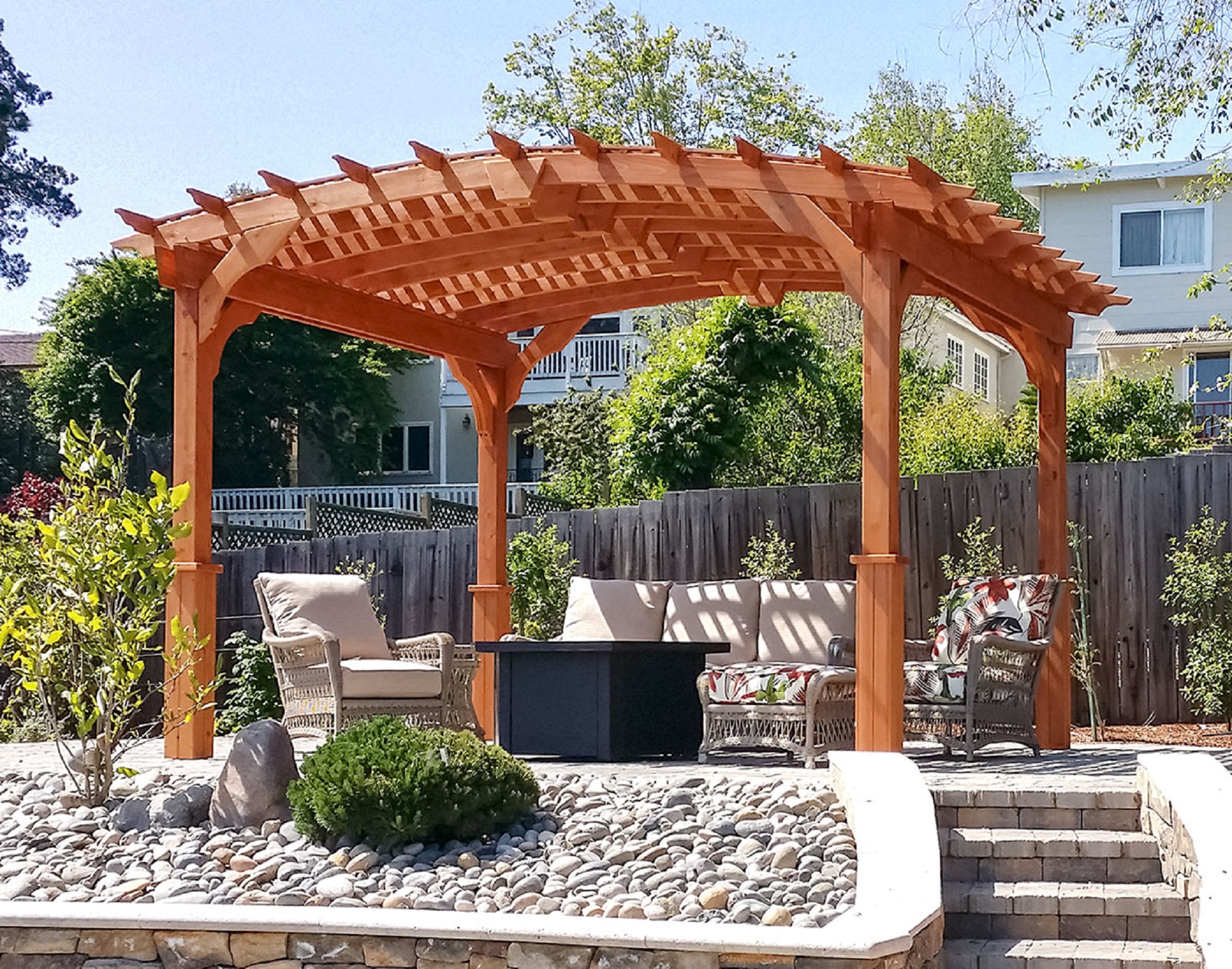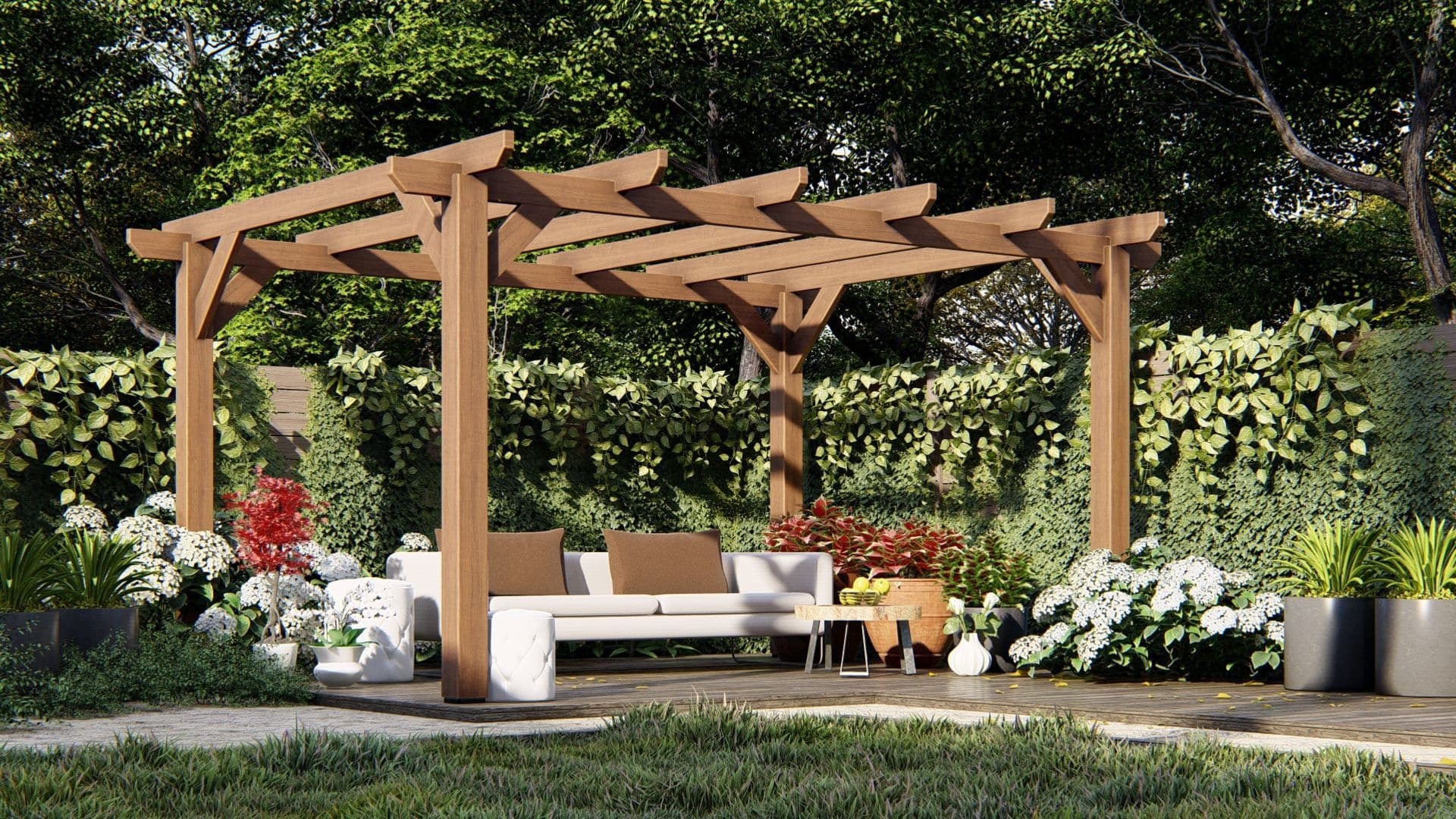A pergola is an outdoor structure that consists of vertical posts or pillars that support an open, horizontal trellis roof. Pergolas are popular additions to backyards and outdoor spaces because they provide shade and visual interest.
Some key benefits of pergolas include creating a relaxation area, enhancing ambience with lighting, directing foot traffic, and growing climbing plants on the trellis. When building pergolas, there are essential considerations like size, style, materials, permits, and hiring a contractor versus DIY.
This article will overview everything you need to know before constructing one of these versatile outdoor structures in your backyard, from vinyl pergolas to freestanding rectangular pergolas. We’ll cover how to choose the perfect pergola design and features to transform your outdoor space into a backyard oasis you can enjoy for years.
Sizing Your Pergola
When building a pergola, one of the first things to consider is how much space you need. Take measurements of your backyard to understand the size and layout. Most designers recommend allotting around 25-30 square feet of space per person for a comfortably sized pergola.
 The materials often used to build pergolas, like wood, vinyl, and aluminium, also come in standard sizes that can help guide your dimensions. For example, many pergolas come in tiny (8×8 feet), medium (10×12 feet), large (12×16 feet) and extra large (16×20 feet) options.
The materials often used to build pergolas, like wood, vinyl, and aluminium, also come in standard sizes that can help guide your dimensions. For example, many pergolas come in tiny (8×8 feet), medium (10×12 feet), large (12×16 feet) and extra large (16×20 feet) options.
Think about the weather conditions in your region, too – larger overhangs are ideal for maximum shade in hot climates. Be sure to check your local building codes for any sizing restrictions. With a firm grasp of your backyard size and the number of people using the space, you will have the knowledge to choose an adequately scaled pergola for your property.
Pergola Material Options
One of the most significant decisions when buying a pergola is which material to build it from. Standard options include wood, vinyl, aluminium and fibreglass.
- Wood pergolas made from cedar or redwood are attractive and versatile for climbing plants but require frequent maintenance.
- Vinyl pergolas are low maintenance but can become brittle in extreme cold.
- Aluminium pergolas are lightweight, durable and easy to maintain but conduct heat.
- Fiberglass pergolas offer strength and weather resistance but are one of the more expensive choices.
Consider your climate and how much maintenance you want when comparing materials.
 Vinyl and aluminium pergolas fare better in rainy regions since they resist rot and rust.
Vinyl and aluminium pergolas fare better in rainy regions since they resist rot and rust.
Attached pergolas are often built from the same materials as the home. Freestanding metal pergolas like aluminium are ideal for mobility. Carefully weigh the pros and cons of each material to select the right option for durability, aesthetics and weather resistance when buying a pergola.
Pergola Design Styles
Pergolas come in many shapes and styles to suit any outdoor area. Two main types are attached and freestanding pergolas.
The attached pergolas are connected to an existing structure like your home. They’re often built from the same materials with features like solid roofs.
 Freestanding pergolas are standalone outdoor structures made from materials like pressure-treated wood. They have an elegant appearance and can be moved if needed. Pergolas also vary in roof design.
Freestanding pergolas are standalone outdoor structures made from materials like pressure-treated wood. They have an elegant appearance and can be moved if needed. Pergolas also vary in roof design.
 Open-roof pergolas provide shade while allowing sunlight and rainfall. Solid roof pergolas create more coverage for outdoor living.
Open-roof pergolas provide shade while allowing sunlight and rainfall. Solid roof pergolas create more coverage for outdoor living.
 Common shapes include square, rectangular, round and oval pergolas. Small pergolas nicely accent smaller spaces. Large rectangular pergolas work well for driveways or backyards. Pergolas offer versatility to customize them to your preferences.
Common shapes include square, rectangular, round and oval pergolas. Small pergolas nicely accent smaller spaces. Large rectangular pergolas work well for driveways or backyards. Pergolas offer versatility to customize them to your preferences.
Consider the location, purpose and aesthetics to select the right pergola shape and style for your outdoor space.
Additional Pergola Features
Beyond the basic structure, many pergolas incorporate features for added comfort, convenience and ambience. For additional shade, curtains can be added to pergola support posts. Ceiling fans promote air circulation while lighting creates a cozy evening atmosphere.
Built-in or freestanding fire pits also add warmth and flair. For dining areas under the pergola, built-in seating like benches, swings or sectionals can provide enough space to entertain guests.
Storage boxes offer hidden spots to stow cushions or outdoor supplies. Pergolas can also integrate other materials like insect-resistant screen mesh for a screened-in porch effect. Consider any plumbing or electrical needs for ceiling fans, lighting or heating.
There are endless options to complement the right pergola and material so it functions as the perfect outdoor living space or dining area. Work these extra pergola features into the overall design for an affordable way to enhance your backyard.
Pergola Permits and Regulations
Before installing a pergola, it is essential to research your local zoning laws and permitting requirements. You will need a building permit for a new pergola in most areas. Permits ensure the structure adheres to safety regulations and construction standards.
Planning permits may be required for aesthetics and placement, while building permits address technical specifications. Standard zoning regulations include height restrictions, often capping pergolas at 10-15 feet tall, depending on location. Setbacks from property lines must also be followed, usually 5 feet from rear lines and 3 feet from sides.
 For the attached pergolas, the same setback rules for the home apply. If you live in a neighbourhood with a homeowners association, ensure the pergola also meets their design guidelines.
For the attached pergolas, the same setback rules for the home apply. If you live in a neighbourhood with a homeowners association, ensure the pergola also meets their design guidelines.
Building a pergola without the proper permits can lead to fines, removal, lack of insurance coverage, and future problems when selling the home. Taking the time to research and obtain needed permits will pay off in the long run.
Hiring a Contractor vs. DIY Pergola Installation
Installing a pergola in your backyard can be done by hiring a professional contractor or as a DIY project. Hiring an experienced contractor ensures proper installation and compliance with building codes. It also saves homeowners time and effort. However, hiring a contractor costs more upfront compared to DIY. Installing a pergola yourself has the benefit of saving money through lower material costs and labour. But remember the skills, tools and time needed to complete the project.
Permits, materials, site prep, concrete footings, and framing require knowledge to be executed properly. Consider your DIY abilities and whether you can safely operate tools like circular saws when deciding between contractor and DIY.
Another option is hiring a contractor for complicated steps like laying the foundation. With the proper planning and skills, building your pergola can be a rewarding experience that saves on installation costs.
Pergola Care and Maintenance
Some regular care and maintenance are required to achieve maximum longevity from your pergola. For wood pergolas, inspect for termite damage, rotting, splintering or loosening joints annually. Use wood cleaners and sealants to prevent weathering. Metal pergolas also need periodic inspections – check for rust, chipping paint or dents.
 Clean metal with mild detergent and touch-up paint when needed. Use vinyl protectants on vinyl pergolas to restore lustre and UV protection. For any material, wash regularly to prevent dirt build-up and mildew growth. Check shade covers and curtains for rips or sagging. Inspect for bee or wasp nests if present.
Clean metal with mild detergent and touch-up paint when needed. Use vinyl protectants on vinyl pergolas to restore lustre and UV protection. For any material, wash regularly to prevent dirt build-up and mildew growth. Check shade covers and curtains for rips or sagging. Inspect for bee or wasp nests if present.
Ensure lighting fixtures are in working order. Taking time for routine pergola inspection and cleaning will pay off with an attractive, durable pergola that lasts years of enjoyment in your backyard space.
Build Your Backyard Oasis with an Aarons Pergola
Adding a pergola can take your backyard to the next level, providing beauty, comfort and entertainment space. The process begins with proper sizing, material selection and style choices for an ideal pergola design.
Obtaining permits, deciding on add-ons like lighting or built-in seating, and planning for maintenance are crucial. With the right pergola, you’ll enjoy hosting gatherings, relaxing in the shade, directing foot traffic, growing climbing plants and boosting your home’s curb appeal.
Let Aarons Outdoor Living turn your yard into the backyard oasis you envision. Our team helps you every step of the way – from planning and permits to professional installation of a customized pergola ideally suited for your space. Contact Aarons today to start designing your dream pergola.
We can’t wait to help build an outdoor living area that becomes your family’s favourite spot to relax, entertain and enjoy more of your beautiful yard.






